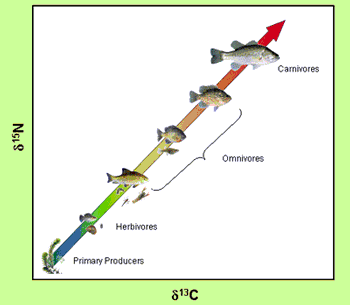You are what you eat
Food Web and its Function
How Are Isotopes of Carbon and Nitrogen Used in Food Web Studies?Isotopes of carbon and nitrogen are used to determine where an animal belongs relative to potential food sources and other animals in its ecosystem. The soft tissue of living organisms is composed of roughly 40% carbon and 10% nitrogen, which are obtained through diet. Animals take on the isotopic composition of the food they eat with a small isotopic enrichment -- the isotopic ratios become higher in both carbon and nitrogen compared to diet, as shown in Figure 1. In this way, we are able to determine at what level an animal is feeding in relation to its ecosystem.
* Laboratory and field studies demonstrate increases in d15N (about 2 to 3 “permil” units) and d13C (about 0 to 1 “permil” units) between consumers and their diet, as shown in the figure above. So “you are not exactly what you eat”. Isotopers refer to this as “you are what you eat plus 2 permil”. |
|
|||||||||||||
Please contact Carol Kendall (ckendall@usgs.gov)
for questions and comments regarding this page.
This page was last changed in June 2003.
To the USGS Home Page
To the Water Resources Information Home
Page

